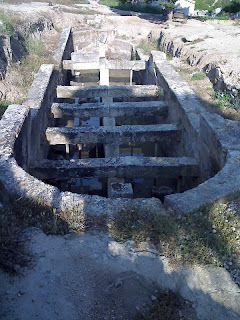I have been coaxing my camera to work since an accident whilst walking at Easter left the lens hanging on by a thread. I could only focus manually but at least I could take some pictures. Yesterday it parted company completely and I can no longer use it. Jane's camera has also stopped working, so I am unable to take any photographs. For me, this is very difficult and I get a twitch every time that a see something worth photographing. I couldn't take any photographs of the Christmas meal yesterday and can't show you the wonderful view from Glenn and Venice's house.
After collecting some more oranges for juicing, we paid for the campsite and left. We headed south to Paralia Tirou to take a look around but that is when the thunder, lightning and rain started and after a brief run to the butcher on the main road, we turned around and headed north.
The bad weather continued and, apart from buying some honey from a roadside stall near Mycenae, we just drove on until we got to Ancient Corinth. We were heading for the Blue Dolphin campsite but spotted some signs to a camperstop close to Ancient Corinth so we decided to follow them.
When we arrived (approx. 15:30) there was nobody around so we parked up and had a cup of tea whilst the rain poured down. Then a man appeared from the house and, giving us a warm welcome, presented us with Greek coffee and 'glyki', literally 'sweets'. Glyki can cover many different things but they are always sweet and are a traditional thing to offer people who come to your house. In our case the glyki were large raisins in a syrup and they were delicious. Later, I returned the tray with many thanks and learned that the owner was taking his grandson Vissilis who learning English to the dentist in Patras.
Between heavy showers and using the map given to us by the campersop owner, we managed to walk the 400 metres into the centre of Ancient Corinth and looked at the site from outside the fences. After dinner I went to the toilet by the house and found the owner cooking souvlaki for the grandchildren. I explained that we had eaten 'arni sto fourno' (lamb in the oven). Vassilis appeared and I asked him how he had got on at the dentist – he showed me the gap where the tooth had been! Something about the meal had got lost in translation as the owner appeared from the house with a bowl of salad for us to have with our meal. It was beetroot and horta (wild greens) in an olive oil and vinegar dressing. It was delicious but we saved most of it to have with our dinner tomorrow.
More thunder and lightning followed in the evening with spells of torrential rain.
The Aphrodite Waters Camperstop (N37.91128 E22.87893) is basic (only one toilet, washbasin and shower combined) but it is very convenient for Ancient Corinth and at €10 including electricity it is very good value. And the owners are very pleasant people! Brush up on your French before you come, it is much better than his English but smiles are international!
Photos: No camera – no photographs.
































